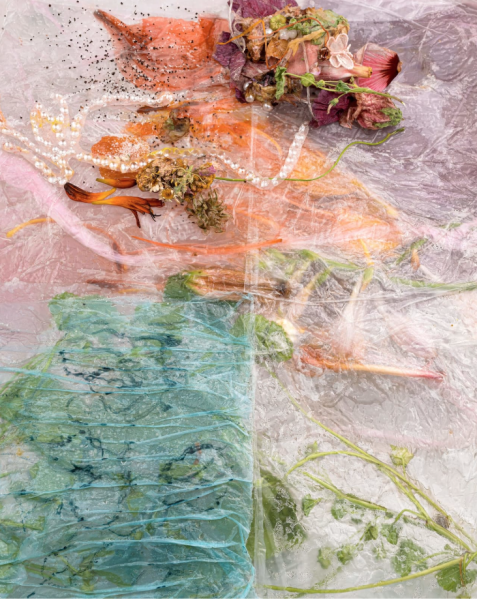Artists
Josep Maria Roset
(Rubí, Spain, 1932 - Rubí, Spain, 2020)
Josep Maria Roset was a Catalan photographer, documentary maker and cultural promoter. For more than 50 years in his profession, he has carried out a valuable photographic documentary work in which he has stood out for photographing subjects of international scope and for an almost notary-like commitment to documenting the time he lived through: the democratic transition in the Vallès region; as well as for the forceful personality of his photographic language.
His personal legacy is one of the most extensive in Catalan photography, with almost three hundred and fifty thousand negatives. His documentary collection, compiled over more than 40 years, is one of the largest in Catalonia on local subjects. Between the historical collection and his personal archive, he has almost half a million photographic objects, including photographic prints, glass plates and celluloid negatives.
He opened his first studio in Rubí in 1957, and between 1959 and 1962 he worked in Madrid and France as a photojournalist, producing highly prestigious photographic reports, such as the wedding of the King of Persia and the death of Dr. Gregorio Marañón. In 1962 he returned to Rubí, where in 1966 he opened a new studio, from where he documented the social life of the town and the region.
In 1967 he took part in the foundation of the Grupo Fotográfico el Gra, and in 1973 he founded with other colleagues the Doble Sis art gallery in Rubí, a reference point for the artistic avant-garde in the Vallès region.
The images shown here under the title The uneasiness of watching are a clear example of some of his work. Photographs created with a firm documentary will but which go far beyond their purpose, revealing a magical costumbrismo full of unexpected discoveries and moments. A look that seeks the extraordinary gesture in the everyday environment. The magic of ordinary days.
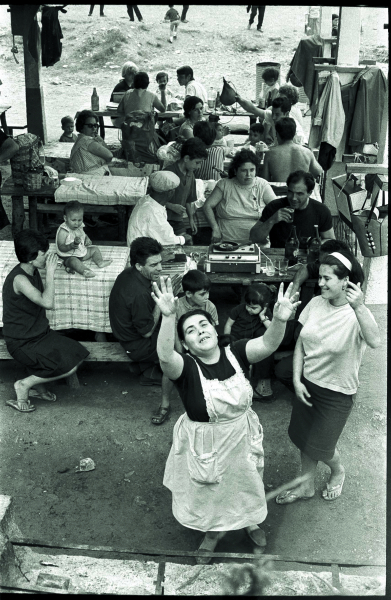
Ignasi Marroyo
(Madrid, Spain,1928- Rubí, Spain, 2017)
Ignasi Marroyo (Barcelona 1928 – Rubí, 2017) is a significant figure in the panorama of 1960s humanist photography in Catalonia. Throughout his career, Marroyo carried out graphic reportage commissions and was among the founders of photographic collectives, such as “El Mussol” within the Agrupación Fotográfica de Catalunya (1960) and “El Gra” (1966), at the Centro Excursionista de Rubí.
The present selection showcases a little-known part of Marroyo’s oeuvre. Since the consolidation of his photographic practice in the early 1960s, the photographer created more than eighty albums with the aim of classifying and editing material coming out his assignments and personal projects. Despite the fact that he never presented in public any of these albums, whose format he regarded as belonging to the intimate and thus more informal realm of the family album, over the decades, he regularly updated them, by adding new sequence and page-layout versions.
Through their stratigraphy of various periods, perspectives and technologies, the albums are the culmination of the practice of a visual documentarian who did not limit himself to being the maker of his images, but explored instead, perhaps more than any other author of his generation, his potential role as editor of his images and custodian of his photographic archive. Marroyo incessantly experimented with narrative sequencing and page-layout, and invented a rigorous classification system for his archive. Arranged into categories according to various themes which are inscribed in the social landscape and customs of his times, the albums express his credo. Even though he never stopped looking for the perfect shot, he envisioned it primarily as part of a "collection", that is, a broader visual narrative unfolding onto the double page. His vision finds there the terrain for exercise, affirming, over the years, its alignment with the official discourse of the humanist photography of his generation.
At a more conceptual level, the albums can be interpreted as an "atlas" of the author's universe in a Warburgian sense of the sense, or rather in a sense closer to Gerhard Richter — although, Marroyo never got to know even remotely any of them. They forge an autonomous visual ecosystem in which coexistence, contaminations, and migrations of images voluntarily or involuntarily take place, next to an unbiased appropriation of resources for the album collage, ranging from digital copies to photocopies. Marroyo stands out for his obsession with “archival order"; he never loses sight of the relevance his images may hold as a legacy for future generations. His albums are inseparable from his biography and an inexhaustible source of documentation encompassing an era.
This exhibition showcases single pages from the albums Braus II (1963-2014) and Mercats (1962-1977). The three of them are dated in the first era of edition of these albums, the early 1960s. Unlike the author’s most well-known images that were authorised by himself to be included in later solo and group retrospective exhibitions and which have are more focused on individual human characters and their customs, the pages on display here are occupied by cinemascope frames that provide a more topographic and iconoclastic view of the urban landscape of the time and its crowds. Amidst the hustle and bustle of the Catalan postwar city of Barcelona, a young, authentic, and ambitious gaze can be seen in the making.
-Natasha Christia-
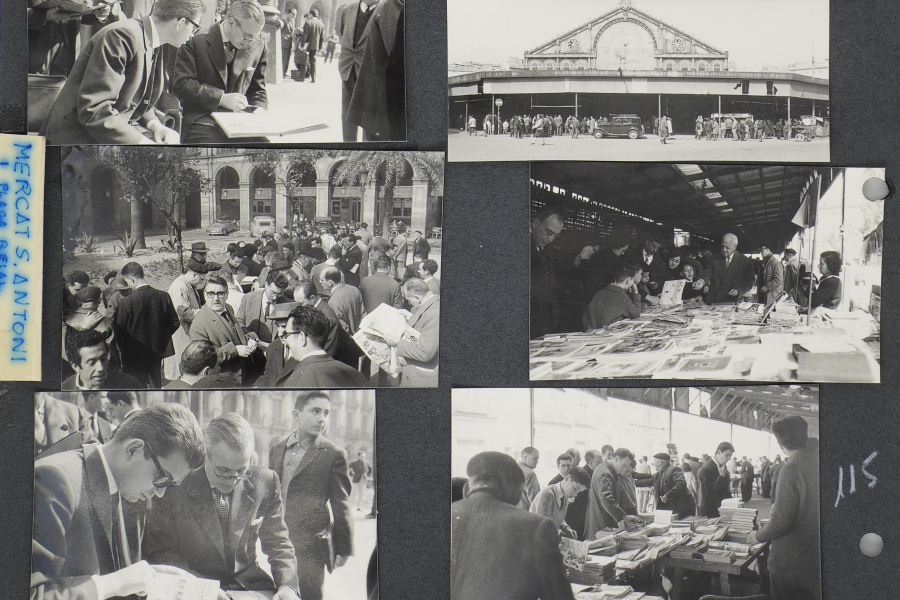
Maria Mavropoulou
(Athens, Greece,1989)
Artist Maria Mavropoulou addresses the intriguing world of the intersection between technology and humanity that runs through our present. Throughout her short but prolific career, she has transcended the conventional boundaries of art to capture the essence of intimacy in the presence of technology. His photography is imbued with modern vibes and a deep commitment to human emotions in the digital world. With a strong background in fine art, he has forged a unique career that fuses creativity and cutting-edge technology: virtual reality, screen captures, GAN image generation or artificial intelligence, to reflect on the ways in which images are produced today. He uses photography as his primary medium, but his work expands beyond conventional photos.
With the series Image Eaters, he focuses on the creation of images and their distribution in an age brimming with visual pollution and, at the same time, questions the two-way relationship between the creators and distributors of images, humans and algorithms.
The main idea came from the realisation of a correlation between images and food. Food is a basic need of every living being, it is fundamental for its growth and survival, while images, on the contrary, are far from being critical for our survival. However, the vocabulary we use to talk about images as ‘food’ feed in social networks or when we say that an Artificial Intelligence system must be fed in order to be trained.
There is a new breed of non-human AI objects and algorithms that depend on images to evolve and survive. And as these intelligent systems and machines take over more and more aspects of our lives, we too are dependent on images in ways we have not yet realised. Technology is constantly evolving and we are becoming more and more dependent on images.
This series aspires to question what an image is today while paradoxically using images to achieve it. The work is inscribed within the scopic turn that is happening today. Images are no longer a representation of the world but are creating a new one, a new reality.
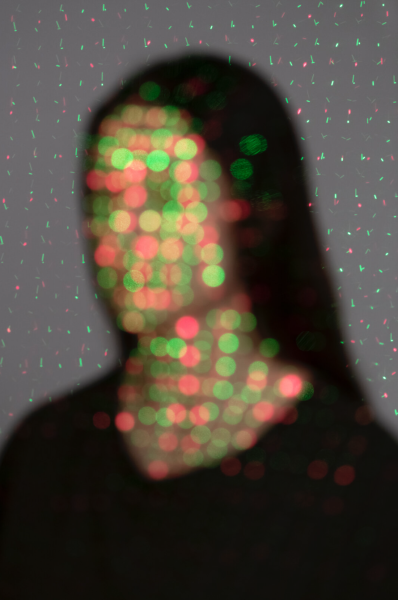
Fina Miralles
(Sabadell, Spain 1950)
Fina Miralles is one of the most significant artists in the field of Catalan visual arts. She began to develop her work in the context of the Franco dictatorship, in a hostile and limiting environment, in which censorship controlled any form of expression under moral impositions. The work of Fina Miralles broke with the academicist proposals of the time and with the established forms of behaviour, redefining the concept of the artistic act. Her production has been ascribed to conceptual art, Land Art and feminism. However, his complexity goes beyond these labels.
In this issue we present a sample of her Fotoaccions, a set of photographs documenting two series of actions. Relación del cuerpo con elementos naturales are sequences of images showing how Fina Miralles' body is progressively covered with different natural elements until it is completely hidden: as if she were visiting herself from head to toe in a dress made of stones, earth, grass or straw. These actions highlight the connections between the human body and the different materials. On the other hand, the relationship between the body and natural elements in everyday actions are images that reproduce some of the actions that make up our daily lives: breathing, looking, washing, eating, walking or smoking. The images constitute a sort of photographic register or diary, a repertoire of everyday acts selected by the artist. Photographs that are made through gesture and action. A performance or performative image that creates and creates through a self-referential and constitutive statement of reality.
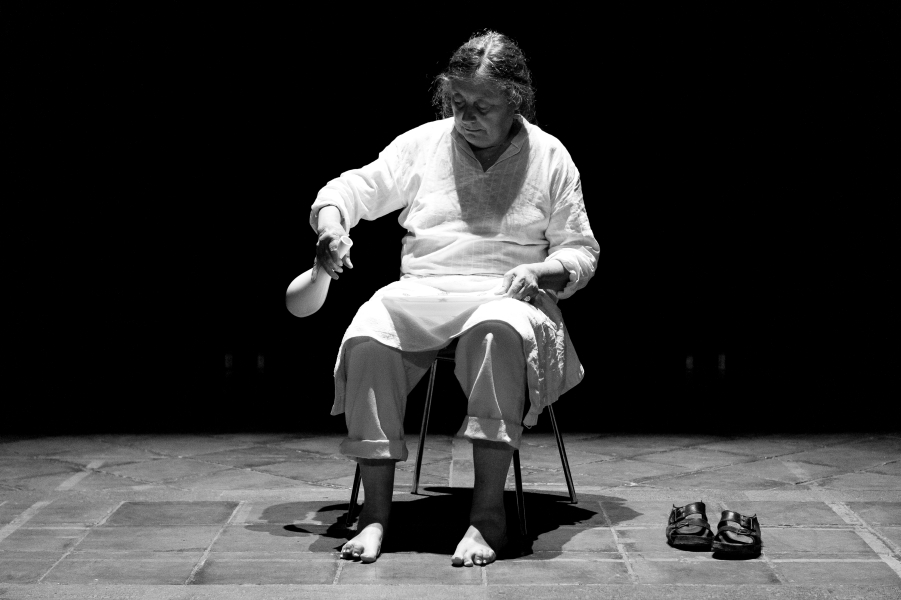
Maria Riot
( Buenos aires, Argentina, 1991)
Maria Riot lives in Barcelona, Spain. She is a sex worker, sex workers' rights activist and artist. She is the author of Archivo puta, a multidisciplinary project that seeks to create archives of the present and search for archives of the past of sex workers, as well as to recover the memory, make visible the beauty and resistance of the collective.
With the photographic project, she seeks to create an archive of the present, since due to the stigma, many sex workers decide to hide and although there are artistic projects about sex work, there are very few that are made by sex workers themselves or without a morbid gaze, with ethics and political context.
Thus, it seeks to challenge the existing gaze of society towards sex workers, but also that of photography and art in general. It foregrounds the agency of the person being portrayed and makes it visible that the person taking the photographs also shares the same labour activity and stigma, something that does not usually happen in the world of photography, where art, due to its lack of accessibility and resources, is not usually made by sex workers on a massive scale and our stories and visual narratives are told by others.
This work makes us ask what is the genealogy of images and their relationship to power: who decides what can be represented in an image? Who manages the prison of forbidden images?
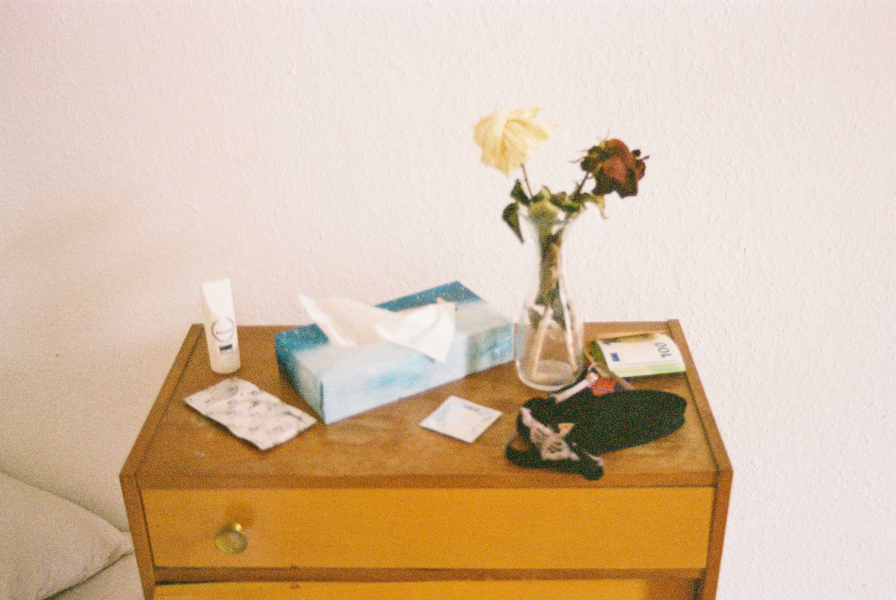
Alba Serra
(Barcelona, Spain, 1984)
For two years Alba Serra has accumulated photographs of places of transit and in parallel has captured snapshots of her private life when she returns to the city. The images, sequenced without a linear narrative order, blur the differences between that which is foreign and that which is personal, local and foreign. The project inevitably becomes a visual essay on uncertainty, and reflects on how fiction is an intimate part of images and of our history.
This visual essay examines how fiction is part of the images we produce and look at. Combining photographs of family and acquaintances with those of people and spaces unknown to the artist, he creates a new narrative in which the boundaries between the personal and the unpersonal are blurred. The title Manual of Russian Gestures is an allusion to a series of possible narratives and suggests an ironic distancing from what may appear to be an intimate diary.
Photography as a network of relations between the real and the dreamed. The image as a fiction. The image as a lie that helps us to discover the truth.
Alba Serra began her approach to the image through fashion, training at various schools in England, Buenos Aires and Barcelona. In the last four years she has specialised in photography and has participated in several international exhibitions and festivals. Recently, she has received the VEGAP grant for visual creation for the development of the ongoing project There Will Be Miracles Here.
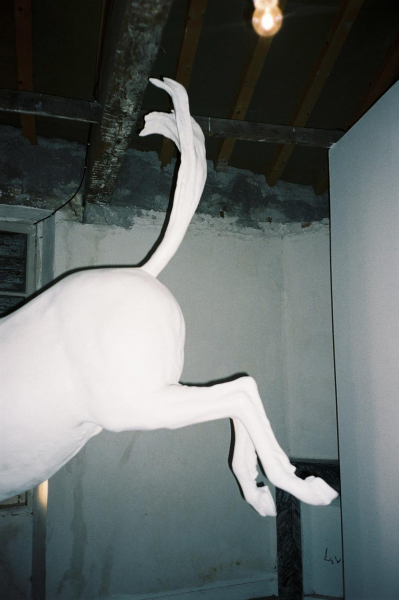
Laura Rodari
(Milano, Italy, 1968)
Self-taught, her photography gravitates around more experimental practices. She works mainly with analogue processes and positives her own negatives. Her work includes other media such as video, digital photography and Polaroid instant material. Since 2015 she is part of the photographic art collective AM Projects together with Oliver Pin-Fat, Tian Doan na Champassak, Olivier Pin-Fat, Hiroshi Takizawa, Thomas Vandenberghe and Daisuke Yokota.
Laura Rodari proposes an aggressive and wild practice that departs from the traditional canons and standards of photographic printing. In her approach to the materiality of photography, to the image-object of emulsified paper, her photographs seem to have been cut with a knife, mistreated and damaged during the process of creation or directly recovered from the wastepaper basket of the laboratory. An extreme experimentation that does not underestimate the humility of error, the use of out-of-date sensitive material or the recycling of collage. Small, shy and minimal photographs, broken and fragmented, shown on cardboard or old folders.
His creative process helps us to reflect on the materialisation and dematerialisation of images, on the frontier between the visual and the intangible. On the persistence of the latent image beyond the revealed and solid image.
According to the author herself, her work Malia came about after a disturbing nightmare. The Italian word Malia means spell but with negative connotations and dark implications. Malia'can also be described as the uncanny ability to achieve unusual and disconcerting effects often in an unobtrusive and subtle way, which makes it all the more deceptive.
Writing the shadow of these ghosts in the darkroom of the laboratory is the core and crucible of her photographs.
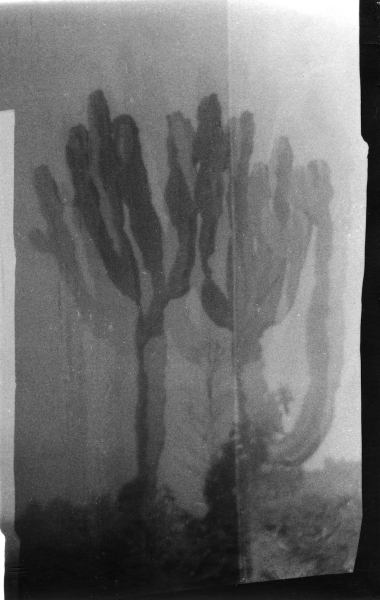
Naïma El Kadi
( Rabat, Morocco, 1980)
Naïma El Kadi studied photography at the Academy of Arts in Bornem and has received a master's degree from the renowned Egyptian photographer Laura el-Tantawy. She currently lives and works in Antwerp (Belgium).
Kadi bases her work on research and often undertakes long-term projects, exploring personal stories related to family relationships, identity and social issues. Kadi moved to Belgium when she was ten years old. He was born in Rabat as his parents had moved from Ait Addoul, a small and remote village in the Rif Mountains, just before his birth. Trying to understand and learn more about his country of origin and where his ancestors came from, Kadi travelled to Morocco, to the village where his parents were born.
His work My Olive Tree, Memouna, translates his search for identity and home into images. ‘My Olive Tree’ refers to the olive trees that grow in the region where they are considered a source of life. An olive tree to which he adds Memouna, the name of the artist's longed-for grandmother.
Most of El Kadi's photographs are dreamlike and blurred, based on distant feelings lost in the past. Through trembling portraits, faces on the verge of fading away and slightly out-of-focus dreamscapes, Naïma El Kadi wants to create new roots. Photographs that symbolise the process of reassembling the images of fragmented and lost memories. The thread that runs through these images attempts to link the past and the present against the backdrop of the beauty of Moroccan nature.
The images made with expired polaroids, their pale colours make us realise the deceptive condition of photographs. A memory is always something we have lost, even if we hold the photograph of this memory in our hands. The burden of images is mysterious like the weight of smoke.
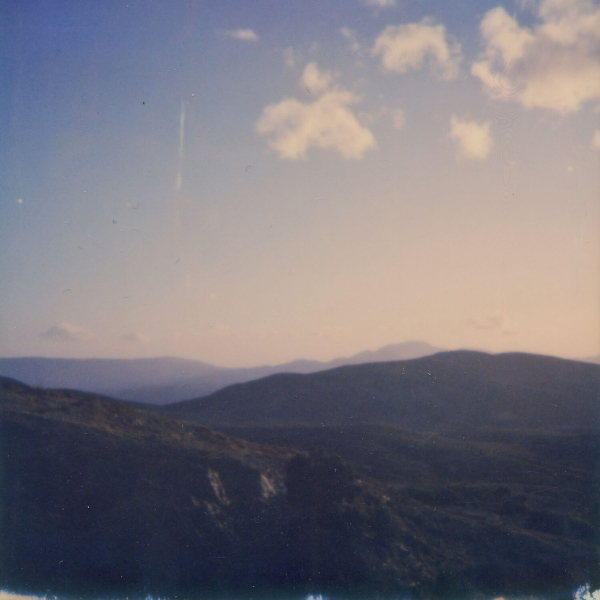
Sergey Prokudin-Gorsky
(Vladimir, Russia, 1863- Paris, France,1944)
Sergei Mikhailovich Prokudin-Gorsky was a Russian chemist and photographer, a disciple of Dmitry Mendeleev, who devoted his career to the advancement of photography and film. He was born in Fúnikova Gorá, Vladimir Governorate in 1863. He studied with famous scientists in St. Petersburg, Berlin and Paris, where he developed the techniques necessary for the first colour photographs. In 1900, the Russian Technical Society presented his black-and-white photographs at the Universal Exhibition in Paris.
His research resulted in the first patents for colour positive film and motion projection film. Around 1905, Prokudin-Gorsky conceived the grand project of documenting, with colour photographs, the enormous diversity of history, culture and progress of the Russian Empire, to be used in the empire's schools.
His process used a camera that took a series of monochrome photos in very rapid sequence, each through a different colour filter. By projecting the three monochrome photos with the appropriate coloured light, it was possible to reconstruct the scene in the original colours. However, there was no mechanism for making prints of the images thus obtained.
In 1918, Prokudin-Gorsky left Russia. After learning of the death of the Tsar and his family, he settled in Paris, where he died in 1944.
The history of images is also the history of their supports: glass, paper, acetate or liquid screen. The technical difficulty of fixing photographs on a surface seems to persist in the phantasmatic character of the latent image and the current digital image. The work we have rescued in this issue belongs to The Memory of Colour and its Technical Reproducibility. In the persistence, in the uneasiness of writing the colour of light through its shadow.
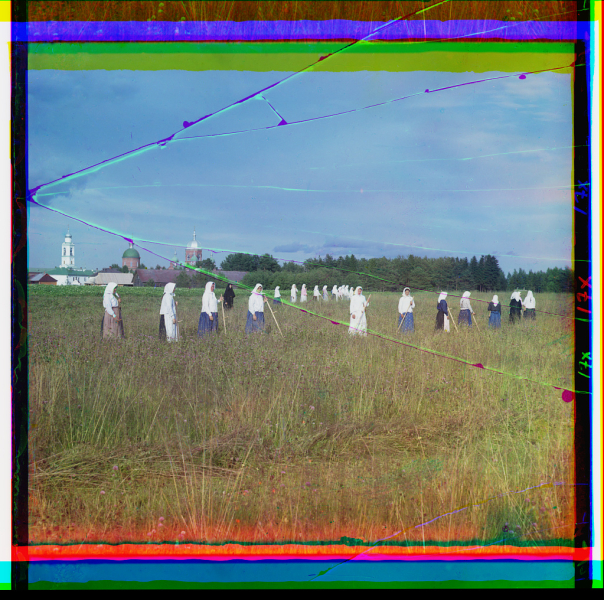
Wouter Van de Voorde
(Gante, Belgium, 1977)
Wouter Van de Voorde is a Belgian artist living with his family in Ngunnawal Land in Canberra, Australia. Raised in rural Flanders he is moving to Ghent to obtain a double Master's degree in Painting and Printmaking from the KASK Academy of Fine Arts. He started out as a painter before discovering that photography offered him more creative freedom and more opportunities for introspection than his original medium. In 2008, he moved to Australia. Influenced by his art academy painting teachers in Belgium and the Flemish school tradition, his photographic work creates haunting and mysterious scenes of the Australian landscape. He usually uses a large-format Linhof Technika V camera mounted on a tripod. The approach of his photographs is determined by the slowness that the use of this camera imposes on him.
The title of the work that has been published in photobook format refers to the family nucleus formed by the photographer, his wife Celia and their children Felix and Flora. Nucleo is a large, layered and somewhat uncomfortable family album. Unlike most family albums, there are few smiles and the loved ones are not in the foreground: they tend to disappear, blending into the vastness of the landscape. A family watching the forest burn, playing in the water and kicking up dust. They wander, doing and undoing things, and the landscape around them is as hostile as it is wondrous. A huge, alienated space in which you could simply disappear. The family forms an organic part and are both witnesses and sometimes intruders. Nucleo is a time capsule that transports us through an unreachable vastness, an ode to life in a house without a roof and without walls. Colour and black and white photographs in different formats where different layers and timelines are encapsulated. The time of the photo, the time of the viewer and the deep time of the land of Australia. The time of the Aboriginal culture whereby the land is a living thing and we are part of it. The landscape has always been here. Images illuminated by the twilight of the days, by the shy light of dusk or the uncomfortable intensity of the flash.
Photographs of the passage of time and its unattainable eternity that at the same time speak to us of the time of images, of their past and their future.
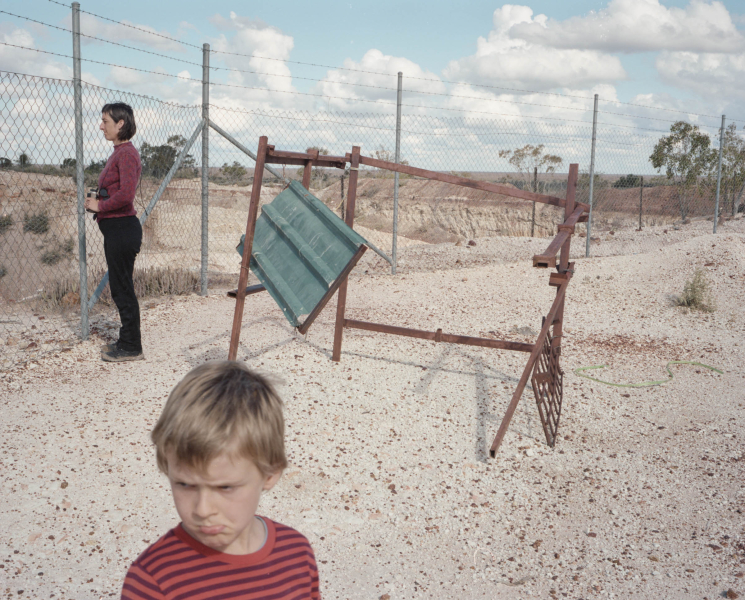
Patrick Taberna
( St Jean de Luz, France, 1964)
Patrick Taberna began photographing during his travels in Europe, Asia, the Middle East and the United States with Nicolas Bouvier's book The Ways of the World in his pocket. Shortly after his arrival in Paris in 1987, he regularly attended the 30×40 Club led by Jean Luc Lemaitre and then Francis Richard. In 1997 he carried out a mail art action: Passage en Ouest where ten people received a different photo-postcard for 37 consecutive weeks. This adventure allowed him, above all, to correspond with his admired photographers Bernard Plossu and Robert Frank. Patrick Taberna won the Fnac Paris prize in 2001 for his work Nos Italies and in 2004 he received the HSBC Foundation prize for Au fil des jours.
His photography - still linked to travel but more intimate - becomes increasingly autobiographical and offers images of a past considered without nostalgia, as a richness that enriches the present.
According to the author, photography, painting, visual arts, poetry, literature, etc... are all false barriers, there are only images that speak.
The series Au fil des jours takes place over 4 years, from 2000 to 2003, the years between the birth of his first daughter Clément and that of his sister Héloïse.These images are created in the course of the days, in the company of loved ones and in the intimacy of her family.Square black and white photographs, all of them poetic. The images he collects help to compose a log of eternal instants, an autobiography of chance that the viewer can use to imagine a story of his own. Imagination and image share the same etymology. All images are a fiction and memory is another invention.
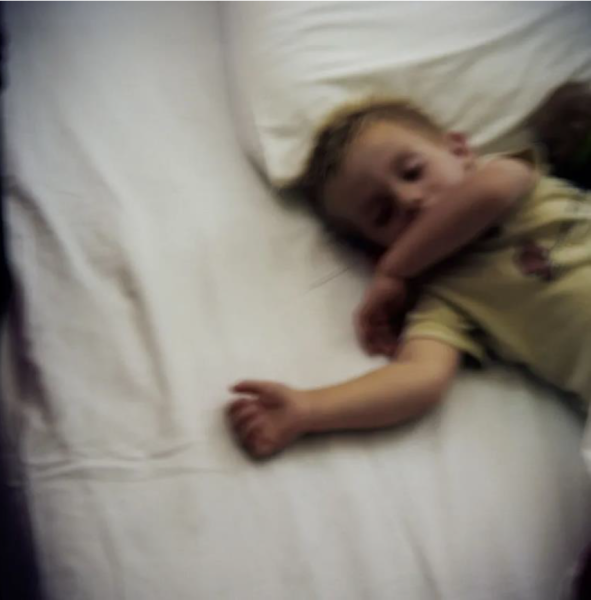
Michelle Bui
(Montreal, Canada,1987)
Michelle Bui’s photographic and sculptural practice reflect the processes of accumulation, presentation, and eventual decay that mark our relationships to seemingly mundane items. Sensual and sensorial, her images point to the negotiation between our understanding of ourselves and the objects that we amass. Gathered primarily from the aisles of grocery, hardware, or craft stores, Bui reframes these objects of a discard-based consumer culture. She parses their formal or material kinships and assembles them into temporary, fragile assemblages that sometimes exist just long enough to be photographed before they collapse, disintegrate, or even decompose. She has had solo exhibitions at the Esker Foundation, Calgary, Contemporary Art Gallery, Vancouver, McBride Contemporain, Montreal, Franz Kaka, Toronto, Parisian Laundry, Montreal, and Galerie de l’UQAM, Montreal and was the recipient of the 2022 the Prix Pierre-Ayot award.
In this recent series, the compositions made of various fragments and debris become slipping glimpses that record a world of material excess. Formal, material, and symbolic affinities have been considered, examined, and assembled into short-lived compositions that undergo changes in phases and state. Existing just long enough to be photographed, the resulting images will, I hope, encourage a conversation between incongruous forms- ricocheting or bouncing from one to another and form a sort of archive that weave in our senses and point towards the cycles of decay and rebirth.
